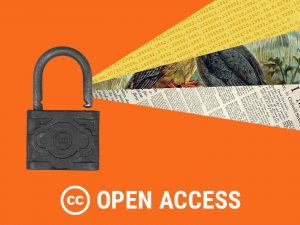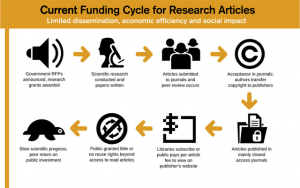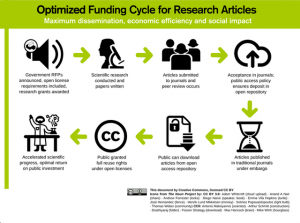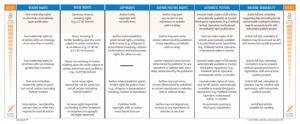5.1 Open Access to Scholarship
Open access content is digital, online, free of charge, and free of most copyright and licensing restrictions on reuse. Open access stands in contrast to the existing “closed” system for communicating scientific and scholarly research. This current approach is slow, expensive, and ill-suited for research collaboration and discovery. And even though scholarly research is largely produced as a result of public funding, the results are often hidden behind technical, legal, and financial barriers or paywalls. Open access publishing is an alternative model — one that takes full advantage of digital technologies, shared infrastructure and open licensing to provide access to scholarship.
Learning Outcomes
- Define Open Access
- Explain the benefits of Open Access for your learners and for researchers at your institution
- Understand how authors can make their own works Open Access
The Big Question / Why It Matters
The purpose of scientific inquiry at the university is the fundamental search for knowledge. Teaching, the open exchange of ideas, and the process of sharing original research are all methods by which academic faculty, learners, staff, and others contribute to advancing scholarship.
How well do current information access and sharing practices within the university system reflect and support the stated goals of research and scholarship?
This unit will explore how the practices and principles of the open access ecosystem and movement align with the goals of improving access to knowledge. It will also address how librarians can support the university in implementing open access practices and policies.

Open Access at CC designed by Amy Collier, copyright owned by Creative Commons. CC BY
Personal Reflection / Why it Matters To You
How does your institution support (or not) the open publication of research? How do you interact with learners and faculty searching for academic research? Have you ever encountered a paywall while trying to access research articles?
Acquiring Essential Knowledge
Open Access
As defined by the Budapest Open Access Initiative (BOAI), Open Access (OA) to research means free “availability on the public internet, permitting any users to read, download, copy, distribute, print, search, or link to the full texts of [research] articles, crawl them for indexing, pass them as data to software, or use them for any other lawful purpose, without financial, legal, or technical barriers other than those inseparable from gaining access to the internet itself. The only constraint on reproduction and distribution and the only role for copyright in this domain should be to give authors control over the integrity of their work and the right to be properly acknowledged and cited.”
Currently, there are a variety of applications of the CC licenses across the open access landscape. Creative Commons advocates for using the most permissive license whenever possible, depending on context. This means that from Creative Commons’ perspective, an aspirational definition of Open Access is the BOAI definition with a recommendation for CC BY, which addresses the definition’s requirement of “any lawful purpose”.
Other definitions of “open” and “open access” include additional CC licenses and tools: CC0, CC BY and CC BY-SA. Many open access advocates and organizations have an even broader definition of what qualifies as Open Access, allowing for more or all of the CC license suite to be applied. Under these definitions, open access content may be licensed with CC BY-SA, CC BY-NC, CC BY-NC-SA, CC BY-ND, as well as CC BY-NC-ND,[1] where the less permissive CC licenses can still meet an institution’s goal of openness.
CC recognizes that different communities of practice have adopted differing definitions of Open Access, depending on their own contexts and community needs, and these should be taken into account when making recommendations. While we always recommend that creators license their material as openly as possible, we also celebrate that sharing work under any of the CC licenses provides more access than default “all rights reserved” copyright allows.
Important components of the OA model include:
- Authors keep their copyright.
- Zero embargo period.
- Openly share the research data with the article.
- Add a Creative Commons license to the research article that enables text and data mining (any of the licenses work, but CC BY is preferred).
See the Budapest +10 recommendations for best practices in creating, adopting and implementing OA policies and processes. For example, “when possible, funder policies should require libre[2] OA, preferably under a CC-BY license or equivalent.”
Scholarly publishing today
First, read the Wikipedia article on scholarly communication. This article defines scholarly communication as “the system through which research and other scholarly writings are created, evaluated for quality, disseminated to the scholarly community, and preserved for future use. The system includes both formal means of communication, such as publication in peer-reviewed journals, and informal channels, such as electronic listservs.”

“Research Article Cycles,” by Billymeinke. CC BY 4.0.
The challenges with the existing approach to scholarly communications are laid out in the graphic above. This image explains—in generalized terms—the current process involved with developing and communicating scientific results. In the first step of the life cycle, scientists, academics, and research institutions seek funds to conduct a variety of research. Most often this funding comes from government sources (e.g., the National Institutes of Health in the United States), although there are several philanthropic foundations (such as the Bill & Melinda Gates Foundation) that are now making major investments in particular types of research.
After the researchers have secured their grants, they conduct their research and collect their data. Most of the time these researchers prepare their results in the form of a publication output such as an academic article or monograph, which they then submit to a scholarly publisher for publication. The publishers then arrange for some of the submitted research to undergo a process of peer review, in which experts within the particular topic of the field will read, review, and usually provide comments on the submitted paper, monograph, book chapter, etc.
Research outputs that pass the peer review stage are then offered for publication. Publishers will notify authors that their works have been accepted, and usually require that the authors transfer copyright to (or agree to an exclusive publishing contract with) the publishers. By accepting these terms, the authors have granted to the publishers their exclusive rights under copyright. This means that the publishers—and not the authors—are now the copyright holders and thus may restrict the terms of access and reuse provided for by the bundle of rights granted to rights holders under the law.
Because publishers have become the de facto rights holders to scientific research, they are also the entities in the position to license access to these materials to university libraries, research institutions, and the public—typically for a significant fee. This leads to a cyclical situation in which for-profit publishers essentially sell back access to the scientific and scholarly record that academics originally produced through public grants.
Even after a publishing embargo (usually a time of 6 months to a year when publishers retain exclusive publishing rights) expires, the access to the mostly-publicly funded scientific research remains limited, with users only permitted to read those articles (if they are properly submitted to institutional repositories). In the end, the public is left with restricted access to the publicly-funded scholarly record, and progress in the scientific enterprise doesn’t reach its maximum potential.
There are several critiques of this academic publishing system. The Scholarly Publishing and Academic Research Coalition (SPARC) has a summary of the key points on its Open Access page, some highlights of which are pasted below:
- Governments provide most of the funding for research—hundreds of billions of dollars annually—and public institutions employ a large portion of all researchers.
- Researchers publish their findings without the expectation of compensation. Unlike other authors, they hand their work over to publishers without payment, in the interest of advancing human knowledge.
- Through the process of peer review, researchers review each other’s work for free.
- Once published, those that contributed to the research (from taxpayers to the institutions that supported the research itself) have to pay again to access the findings. Though research is produced as a public good, it isn’t available to the public who paid for it.
© 2007-2017 SPARC, CC BY
As ever-increasing journal prices outpace library budgets, academic libraries are forced to make difficult decisions — often having to cancel subscriptions or shift money away from other budget items. The Association of Research Libraries member institutions (some of the most well-funded institutions in North America) report spending about $1 billion per year purchasing subscriptions to journals. Since 2003, average journal prices have been rising about 9% per year.
Open Access Publishing
The “closed access” publishing system limits the impact of the scientific and scholarly community and progress is slowed significantly. Open Access literature is defined by scholar Peter Suber as “digital, online, free of charge, and free of most copyright and licensing restrictions.” Read the graphic below for a quick overview of how an open access publishing system works.

“Research Article Cycles,” by Billymeinke. CC BY 4.0.
In contrast to the earlier graphic that explained the current costly and inefficient science publishing life cycle, the image above explores an alternate path—an open access route.
The process begins just as it did in the explanation of the incumbent system—with government requests for proposals (RFPs) for research. In the open access route, RFPs contain policy language requiring research to be published in open access formats.
Next, researchers conduct their research and prepare their academic manuscripts. When they go to submit their research to publishers, they must think about the open access policy requirements they agreed upon when they accepted their grant funding. This means that the researchers must retain their copyrights—and not sign them over to for-profit publishers. Or authors must search out a “gold” open access journal, which publishes research under liberal open access licenses (like CC BY) at publication. In either case, authors retain some—or all—rights to their research articles, permitting them to publish under open access licenses, and ensuring that they may deposit their articles in a university or institutional repository for long-term access and preservation.
By publishing under open licenses, subsequent users are granted the legal permissions to access and reuse the research. This type of open access system is better aligned with the original purpose of conducting science and sharing results openly through the scholarly publishing process. Ultimately, the open access approach is more efficient, equitable, affordable, and collaborative.
Watch the Open Access Explained! Video.
“Open Access Explained!” Attributions: Animation by Jorge Cham Narration by Nick Shockey and Jonathan Eisen Transcription by Noel Dilworth Produced in partnership with the Right to Research Coalition, the Scholarly Publishing and Resources Coalition and the National Association of Graduate-Professional Students. CC BY 3.0.
Open Access Options
Open Access authors have the opportunity to publish in a few ways. The most common are known as “Green” or “Gold” Open Access.
Green OA = making a version of the manuscript freely available in a repository. This is also known as self-archiving. An example of green OA is a university research repository. OA repositories can be organized by discipline (e.g. arXiv for physics) or institution (e.g. Knowledge@UChicago for the University of Chicago).
Gold OA = making the final version of the manuscript freely available immediately upon publication by publishing in an Open Access journal and making the article available under an open license. Typically, Open Access journals charge an Article Processing Charge (APC) when an author wishes to (a) publish an article online allowing for free public access and (b) retain the copyright to the article. APCs range from $0 to several thousand dollars per article. Read more about APCs at Wikipedia. An example of a gold OA journal is PLOS.
Diamond OA = a scholarly publication model in which journals do not charge fees to either authors or readers. Diamond OA journals are one type of community-driven, academic-led and -owned publishing initiatives. Diamond OA journals are designed to be equitable by nature and design and seek to support bibliodiversity through multilingual and multicultural scholarly communities.
The Directory of Open Access Journals (DOAJ) is a site that indexes open access journals, and HowOpenIsIt? (see below) is a handy tool for evaluating the relative “openness” of publishing from full open access to closed access.

HowOpenIsIt? Guide by SPARC AND PLOS. CC BY.
Certain emerging models like preprints and hubs are rapidly emerging, but they can provide a new way of considering Open Access publishing outside of the constraints of publisher-mediated models. See the additional resources section for more information about these emerging areas in Open Access publishing.
Educating authors about their publishing rights
By understanding copyright and the various scholarly publishing options, librarians can help faculty members and graduate learners navigate the system as they publish research.
Often, scholarly publishers require authors to transfer their rights to publishing companies before their research will be published. Academic librarians and other library departments can support faculty and student authors by helping them understand what they give up when they transfer their copyright to a publisher. For example, scholarly authors who transfer copyright could lose the ability to post their research on their own websites.
Several tools exist to help faculty and scholars understand their rights and publishing options, and to help them exercise those rights. The Termination of Transfer tool,[3] co-stewarded by Authors Alliance and Creative Commons, gives authors who have previously entered into publishing agreements information about whether and how they can regain the publication rights previously assigned away so they can publish on new terms, including under a CC license if they choose. The Scholars Copyright Addendum Engine can be used by faculty and other authors to amend publication agreements when submitting an article to a traditional publisher.[4] The engine allows authors to choose among different options to reserve rights for themselves, and generates an agreement that is then submitted with a traditional publication agreement to make that legally effective. Additionally, Authors Alliance publishes myriad resources about these tools and open access, and PLoS offers resources and articles about the benefits of open access as well.
Academic librarians can also help scholars understand how different publishing options affect the audience and prestige of their work. Impact factor is a primary metric of prominence of a journal or publication, measured by a journal’s average number of citations. Because impact factors are not necessarily a reliable metric of a journal’s importance, some publishers like Nature, are reconsidering the importance of impact factors for journals. Many Open Access scholars encourage systems like altmetrics to provide another way of thinking about impact beyond the traditional metrics. In 2017, 1Science OA- Finder released a study finding that on average, Open Access papers produce a 50% higher research impact than strictly paywalled papers. For more information, Read Jon Tennant’s article from 2016 on the academic, societal, and economic advantages of open access to learn more. It’s also important to be aware of potential disreputable journals or exploitative publishing practices, which can be either closed or open access. Wikipedia provides a summary of what is sometimes known as “predatory publishing,” with links to additional resources for those interested in exploring this topic further.
Open Access practices and policies at the university and beyond
An open access policy is a formal policy adopted by an institution to support researchers in making their work openly available. These policies can refer to published peer-reviewed articles, conference papers, and/or peer-reviewed drafts or pre-printed publications that are deposited in an institutional repository or published under open access terms in a journal. Open Access policies generally define the guidelines for how researchers can disseminate their research to maximize access. The Registry of Open Access Repository Material Archiving Policies (ROAR Map) is a registry that charts open access policies or mandates adopted by universities, research institutions, and research funders that require or request their researchers to provide open access to their peer-reviewed research article output by depositing it in an institutional repository or publish under open access terms in a journal.
Open Access advocate Peter Suber has remarked that “mandate” is not a good word for open-access policies, “…but neither is any other English word.” Without a mandate, institutions can consider faculty opt-in policies, where libraries or copyright offices focus on shifting the default publishing practice to open access.
University policies
Many universities have adopted open access policies that require university-affiliated researchers to grant to their institution a non-exclusive license to a scholarly article at the time of creation of the work. This process heads off problems with publishers downstream, since the university retains a legal right to the work before copyright is transferred to a publisher. These policies have proliferated under the assumption that universities themselves should be able to access and preserve the research outputs of their faculty. To view an example, review the University of California Open Access Policy. You can also view many other institutional open access policies in the ROARMAP, which has collected several hundred open access policies, including those of universities, research organizations, and academic institutions.
For academic librarians interested in developing an open access policy for their university or institution, the Harvard Open Access Project has developed a toolkit. Open Access policies usually originate from the Office of Scholarly Communications, but librarians in a variety of roles (outreach, reference, etc.) can help craft these policies.
Public policy
In addition to encouraging the development of open access policies at the university level, public policies can ensure that publicly funded research be made available under Open Access terms. This typically is accomplished through the inclusion of sharing requirements tied to receiving government or philanthropic grant funds. When funding cycles for research include deposit and/or open license requirements for publications, increased access and opportunities for reuse extends the value of research funding.
One example is this U.S. White House Office of Science and Technology Policy (OSTP) memo from 2022 (CC blog post). This memo guides all federal departments and agencies to make publications and research funded by taxpayers publicly accessible, without any embargo or cost. The plan is for this guidance to be fully implemented nationwide by the end of 2025, but many federal departments and agencies have already issued new policies and procedures under the Biden-Harris administration to begin making publications and research outputs more available. Examples of some of these policies can be found in the OSTP’s 2023 fact sheet, which includes updated definitions of open science, new online resources, evolving grant requirements, greater access to government data through online portals.
Enforcing Open Access Policies
The point of most open access policies is to ensure that publicly (or foundation) funded research can be read by everyone, and is – ideally – openly licensed with a zero embargo period. When it comes to enforcing open access policies, multiple people play important roles.
The funder and its program officers need to understand the open access policy, communicate the importance of it to grantees verbally and in writing, and follow-up by checking to ensure the public has full access to the research and data under the terms of the OA policy.
The university / college administration should provide support (e.g., hire a full-time OA / OER librarian) to faculty publishing in open access journals or otherwise sharing their research openly. Institutions can also review and modify (as needed) promotion and tenure policies to ensure faculty engaged in OA publishing are rewarded (not punished) during promotion and tenure review.
Open Access Myths Debunked
For faculty and learners, Open Access can seem like a scary new world, particularly as the pressure to publish has increased. There are many guides to debunking the myths of Open Access publishing, and reading them carefully to dispel any fear or misunderstanding is crucial in the current academic landscape.
- Peter Suber’s “Field Guide to misunderstandings about Open Access”
- University of Minnesota “Myths about Open Access Publishing.”
- Mike Taylor’s “Persistent Myths about open access scientific publishing”
Final remarks
Universities play a major role in advancing scientific research, and academic publishing is a key way for faculty to communicate findings with colleagues and the public. As organizers of knowledge within institutions, librarians can work together with university researchers to promote access to information. They can do this by educating on the “how” and “why” of Open Access, answering questions about copyright, and providing guidance and recommendations to maximize the reach and impact of scholarly publishing in particular fields.
- The Scholarly Publishing and Academic Research Coalition (SPARC) defines Open Access as “the free, immediate, online availability of research articles combined with the rights to use these articles fully in the digital environment.” This would imply that most of the CC licenses, save for CC BY-ND and CC BY-NC-ND, would be allowed. ↵
- For context, SPARC uses the term “gratis OA” for the removal of price barriers alone and “libre OA” for the removal of price and at least some permission barriers, as noted on their website. ↵
- Currently, the Termination of Transfer tool covers U.S. copyright and contracts controlled by U.S. law only. Creative Commons is working to expand the tool to provide information and resources about provisions with similar effect around the world. ↵
- The SCAE and the addenda are being updated by Creative Commons in 2019. ↵